Media
Transcript
Yesterday, we talked about the accelerated timeline for OSIRIS-REx to stow the sample from Bennu. And we said we would update you all once we had new information. Of course, right after we went off the air yesterday, there was a quick press conference to let everyone know that the sample is officially secure and sealed in the Sample Return Capsule. Congratulations to the mission team!
The next step is to prepare OSIRIS-REx for the return journey to Earth, and that departure window opens in March 2021, so please stay tuned.
As much as we could talk about OSIRIS-REx and Bennu all day long, there is other news. Have no fear, however, today’s episode of Astronomy Cast will do a deep dive on this rock tossing combo.
For now, though, we switch fields and look at black hole populations. These no-give, only-eat non-light sources are hard to survey with light, but in recent years it has finally become possible to detect them through gravitational waves when they merge. Since black holes of different sizes produce gravitational waves of different frequencies, observing runs by the LIGO and VIRGO gravitational wave detectors are allowing us to build up a census of what size black holes are out there merging.
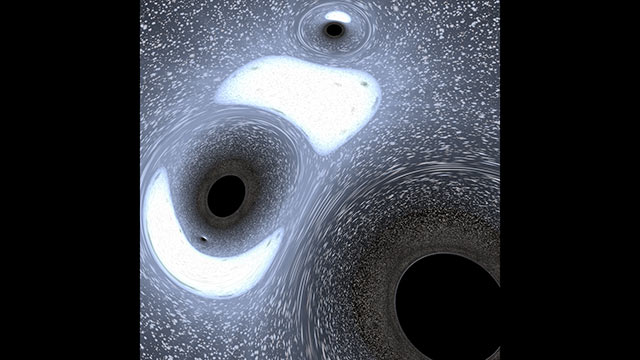
During the most recent observing season, a record-breaking 39 mergers were detected thanks to improvements in the detectors; these are the improvements that we have previously discussed that make the detectors so sensitive they detect the quantum noise in the systems forty-some-odd kilogram mirrors. While we don’t normally cover work that hasn’t yet gone through peer review, we want to discuss this because the LIGO-Virgo team has posted all their results and their submitted papers online so that other researchers can use these observations to test their work and advance their theories.
According to team member and graduate student Daniel Wysocki: This catalog represents a significant increase in sample size from our previous release. It’s like a census that provides data for people to see if their physical models are consistent with what happens in the universe. This has implications for general relativity, the physics of stars, and the behavior of matter at energies that aren’t possible in a terrestrial laboratory. Down the line that can really help us change our understanding of things on Earth.
With the addition of these 39 objects, our list of gravitational wave detections totals fifty. It’s not a statistically well-sampled population, but it is working its way in that direction.
Closer to home, we have news this week of yet another interesting molecule found in the atmosphere of a world we hope harbors life. This time, that world is Saturn’s moon, Titan, and that molecule is, bear with me here, cyclopropenylidene, which is three carbon atoms and two hydrogen atoms. Scientists think this compound could be the precursor to even more complex molecules that could feed life on Titan.

A team of researchers looked through spectra collected by the Atacama Large Millimeter/submillimeter Array (ALMA) to understand the composition of Titan’s atmosphere and found the molecule in their analysis. While C3H2 has been found elsewhere in the galaxy, it has not been found in an atmosphere. The molecule has only been found in pockets of interstellar gas and dust because it is highly reactive with other molecules, and in interstellar space, the conditions are too cold for those reactions. In this instance, cyclopropenylidene was found in the upper layers of Titan’s atmosphere, where there are not many other gases to react with.
The findings are intriguing because Titan’s thick atmosphere and meteorological conditions are unique among moons in our solar system. As the press release states: Titan’s atmosphere is made mostly of nitrogen, like Earth’s, with a hint of methane. When methane and nitrogen molecules break apart under the glare of the Sun, their component atoms unleash a complex web of organic chemistry that has captivated scientists and thrust this moon to the top of the list of the most important targets in NASA’s search for present or past life in the solar system.
To find out if Titan is habitable, we need to understand what kinds of compounds make it from the atmosphere to the surface, which is where the upcoming Dragonfly mission comes in. Titan’s surface could have similar conditions to early Earth as it was 3.8 to 2.5 billion years ago when our atmosphere had more methane than oxygen.
Melissa Trainer, deputy principal investigator of Dragonfly stated: We think of Titan as a real-life laboratory where we can see similar chemistry to that of ancient Earth when life was taking hold here. We’ll be looking for bigger molecules than C3H2, but we need to know what’s happening in the atmosphere to understand the chemical reactions that lead complex organic molecules to form and rain down to the surface.
Cyclopropenylidene, like benzene, is a closed-loop molecule that could be involved in creating the structure of DNA and RNA. For now, scientists are working to learn more about this small compound and understand how it might react with other gases in Titan’s dense atmosphere. We will have to wait for Dragonfly to arrive before we answer the question of what compounds make it to the surface and how habitable that surface might be for primordial life.
Titan’s atmosphere, like Earth’s atmosphere, interacts with the world’s surface. In a new paper appearing in Astronomy & Astrophysics, Anezina Solomonidou and collaborators analyzed mosaics of an image obtained by the Cassini mission.
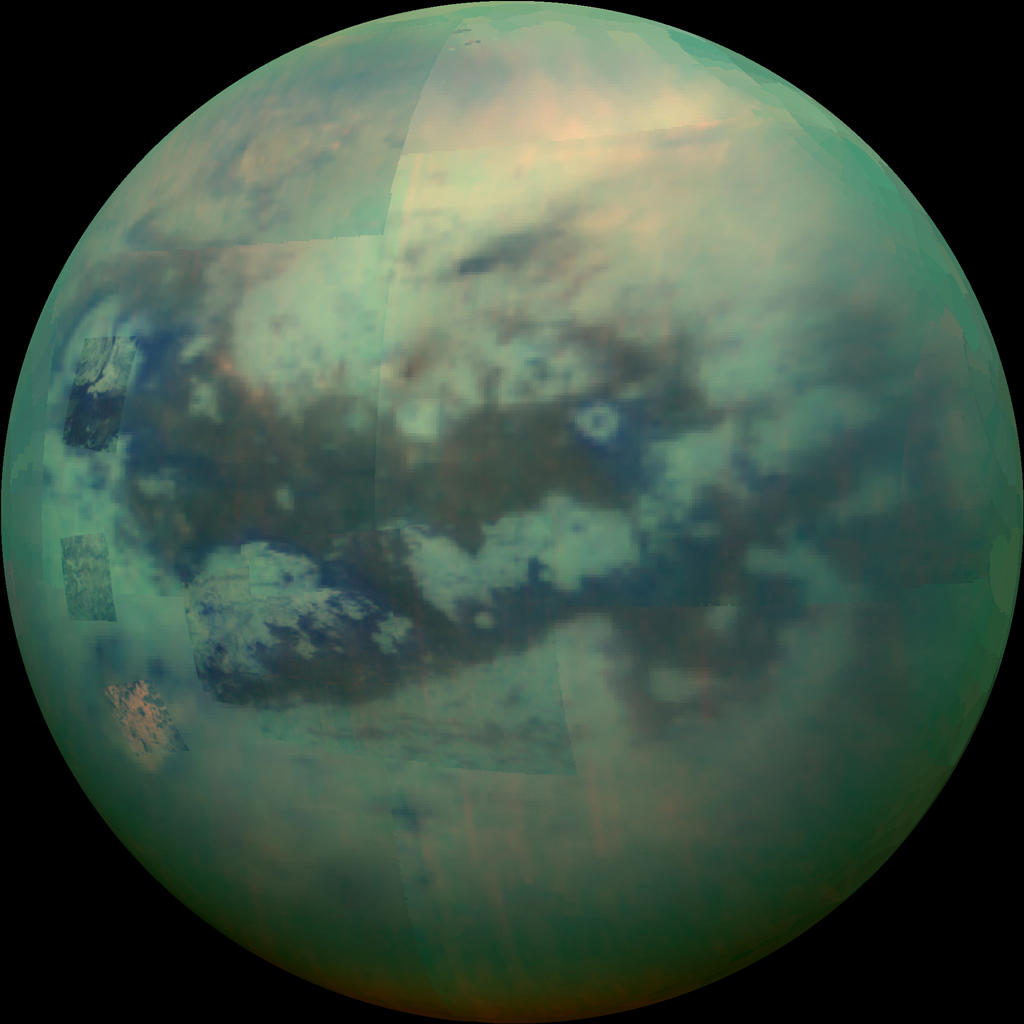
These infrared and visible light images were able to peer through Titan’s clouds to see the craters that pockmark its surface. Since craters can be found at every latitude on Titan, they allow scientists to study how storms and other atmospheric interactions act differently in different places. We see this on Earth where dust storms cover roads in sand in mid-latitudes, while snow will coat roads in polar latitudes, and rains will simply remove roads where the conditions are right.
According to co-author Catherine Neish: Titan has weather. It’s not unlike the Earth in that way. It’s just that the ingredients are all wrong. It has methane rain and streams cutting through the surface and organic sand getting blown around. It’s still very active just like it is here on Earth.
According to the NASA press release: Some of the new results reinforce what scientists knew about the craters – that the mixture of organic material and water ice is created by the heat of impact, and those surfaces are then washed by methane rain. But while researchers found that the cleaning process is happening in the midlatitude plains, they discovered that it’s not happening in the equatorial region; instead, those impact areas are quickly covered by a thin layer of sand sediment.
Solomonidou explains: The most exciting part of our results is that we found evidence of Titan’s dynamic surface hidden in the craters, which has allowed us to infer one of the most complete stories of Titan’s surface evolution scenario to date. Our analysis offers more evidence that Titan remains a dynamic world in the present day.
Dragonfly is planned to launch in 2027, and I think all of us would like a fast forward button to see what it will see.
We have talked a lot about Bennu lately, but OSIRIS-REx wasn’t the first mission to smack an asteroid in the hopes of getting a sample. Back in April of 2019, Hayabusa2 sent a projectile at the surface of asteroid Ryugu, creating an impact crater. The impactor was about 13cm and left a crater about 14.5m in diameter.
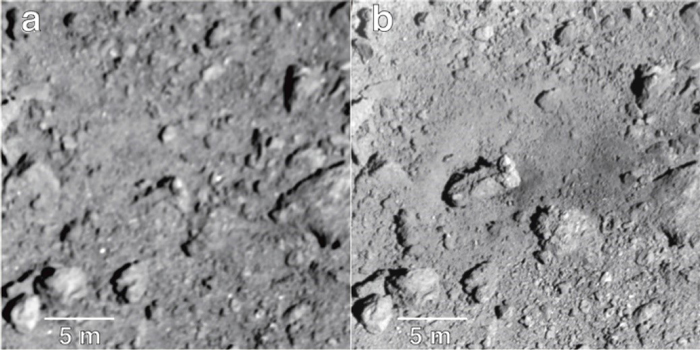
This week, the mission team presented an analysis of the physical results of the impact at the AAS Division for Planetary Sciences meeting. More than 200 boulders were either new to the images or moved from elsewhere, and they ranged in size from 30cm to 6m. The shaking from the impact actually displaced material as far away as 40m from the center of the crater.
The sample collected from the impact is on its way back to Earth as we speak, but the analysis of the displacement is useful for understanding how small body collisions work and how resurfacing works under low gravity conditions. The data may even assist in the upcoming DART mission we talked about last week. Everything is tied together, y’all.
One of the more annoying things about solar systems is planets and other objects don’t stay in one place or even in one orbit. Over time, gravitational interactions can radically change positions and collisions. Well, they can change everything.
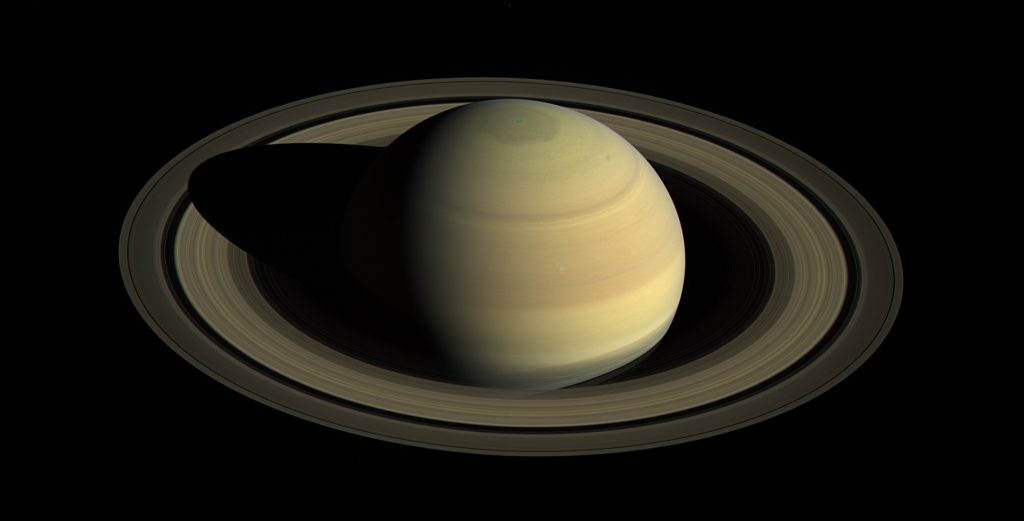
We’d love to understand the history of our solar system, but the only way to do this is to measure where things are now and how they are moving and to then work backward and try and figure out what happened. A good model will explain details like the Great Heavy Bombardment, when asteroids careened into every solid surface we can see. It will also explain how Uranus and Neptune ended up so far from the sun.
As computers get better, scientists can include more and more details in their models, better-approximating reality. In new models published by Matt Clement and collaborators, they ran 6000 simulations of our solar system’s evolution and realized the relationship between Saturn and Jupiter likely wasn’t what we thought it was.
Prior work indicated clearly that these two worlds were once in resonance, with the two planets orbiting so that they lined up over and over with the sun in the same place. It was thought this was a three to two resonance, with Jupiter orbiting three times for every two orbits of Saturn. These new models, however, indicate that it was more likely a two to one resonance, with two Jupiter orbits for every one Saturn orbit. They also found that the positions of Uranus and Neptune were influenced by how much material was in the outer solar system’s Kuiper Belt. This complex interplay of the Kuiper Belt’s gravity and Saturn and Jupiter’s resonance also seems to have kicked out an ice giant from our solar system. This is very much a science of shadows situation, where researchers find missing objects by the shadow they leave in the solar system’s current makeup.
For our final story of the day, we bring you the news that Kepler is the gift that keeps on giving. Although its mission ended, the data collected continues to be analyzed. A new paper in the Astronomical Journal estimates that there could be as many as 300 million potentially habitable planets in our galaxy, and some may even be as close as 30 light-years of the Sun.
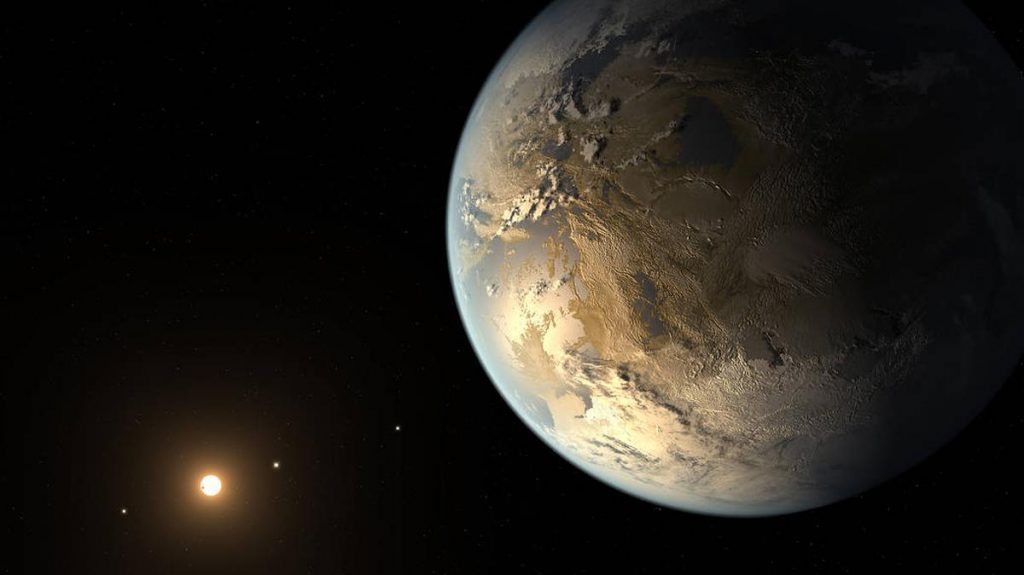
Co-author Jeff Coughlin, an exoplanet researcher at the SETI Institute and Director of Kepler’s Science Office, stated: This is the first time that all of the pieces have been put together to provide a reliable measurement of the number of potentially habitable planets in the galaxy. This is a key term of the Drake Equation, used to estimate the number of communicable civilizations — we’re one step closer on the long road to finding out if we’re alone in the cosmos.
The Drake Equation uses probability to theorize how many technologically advanced civilizations might be in our galaxy. It is not a mathematical equation that can be solved, as we don’t know the statistical values for each variable, yet. Instead, we estimate those values as we get more and more data, something Kepler provided a lot of.
Per the press release: …the researchers looked at exoplanets similar in size to Earth and thus most likely to be rocky planets. They also looked at so-called Sun-like stars, around the same age as our Sun and approximately the same temperature. Another consideration for habitability is whether the planet could have the conditions necessary to support liquid water.
That all sounds familiar. What is new here is that the team also used data from the European Space Agency’s Gaia mission to understand how much energy a planet’s star emits, taking into account the amount of light hitting the exoplanets. The new results now give a better picture of the diversity of the stars, solar systems, and exoplanets we can find.
Next for the team is an analysis of the role a planet’s atmosphere plays in the ability of the exoplanet to support liquid water. As we continue to narrow in on what may be out there, we can narrow down the search for life beyond our solar system.
Learn More
NASaA’s OSIRIS-REx Successfully Stows Sample of Asteroid Bennu
Bumper Crop of Black Holes in New Gravitational Wave Paper
- Northwestern University press release
- University of Portsmouth press release
- Rochester Institute of Technology press release
- “Population Properties of Compact Objects from the Second LIGO-Virgo Gravitational-Wave Transient Catalog,” R. Abbott et al., submitted to the Astrophysical Journal Letters, 28 October 2020. (preprint on arxiv.org)
- “GWTC-2: Compact Binary Coalescences Observed by LIGO and Virgo During the First Half of the Third Observing Run,” R. Abbott et al., submitted to arxiv.org, 27 October 2020. (preprint)
- “Tests of General Relativity with Binary Black Holes from the Second LIGO-Virgo Gravitational-Wave Transient Catalog,” R. Abbott et al., submitted to Physical Review D, 27 October 2020. (preprint on arxiv.org)
NASA Scientists Discover ‘Weird’ Molecule in Titan’s Atmosphere
- NASA article
- “Detection of Cyclopropenylidene on Titan with ALMA,” C.A. Nixon, et al., 15 October 2020, Astronomical Journal.
Craters Reveal Details of Titan’s Dynamic Surface Weathering
- NASA JPL press release
- Western University press release
- “The Chemical Composition of Impact Craters on Titan. I. Implications for Exogenic Processing,” A. Solomonidou, C. Neish et al., 2020 Sep. 1, Astronomy & Astrophysics
Asteroid Ryugu Shaken by Hayabusa2’s Impactor
- Kobe University press release
- “An Artificial Impact on the Asteroid (162173) Ryugu Formed a Crater in the Gravity-Dominated Regime,” M. Arakawa et al., 2020 April 3, Science
- “Seismic Waves Induced by High-Velocity Impacts: Implications for Seismic Shaking Surrounding Impact Craters on Asteroids,” K. Matsue et al., 2020 March 1, Icarus
Where Were Jupiter and Saturn Born?
How Many Habitable Planets Are Out There?
- SETI Institute press release
- NASA Ames article
- “The Occurrence of Rocky Habitable Zone Planets Around Solar-Like Stars from Kepler Data,” Steve Bryson, Michelle Kunimoto et al., 2020, to appear in the Astronomical Journal (preprint on arxiv.org)
Credits
Written by Pamela Gay and Beth Johnson
Hosted by Pamela Gay and Beth Johnson
Audio and Video Editing by Ally Pelphrey
Content Editing by Beth Johnson
Intro and Outro music by Kevin MacLeod, https://incompetech.com/music/


 We record most shows live, on Twitch. Follow us today to get alerts when we go live.
We record most shows live, on Twitch. Follow us today to get alerts when we go live.